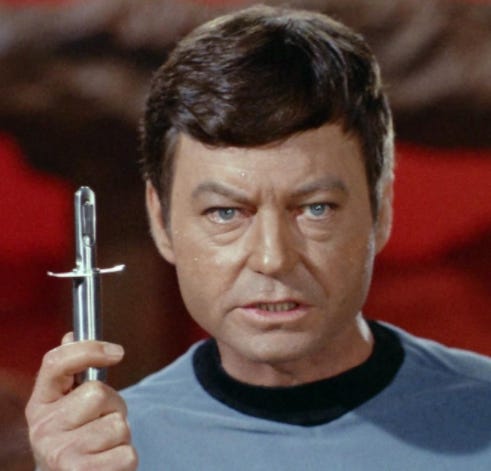Dr. McCoy's Hypospray On 'Star Trek' Is Real World Tech
Don't Like Needle Jabs? It's Bones & Trek Tech To The Rescue.
"I'm not a magician, Spock, I’m just an old country doctor." TOS: The Deadly Years
Looking back on creator Gene Roddenberry’s original Trek, and being entirely truthful, didn’t Bones seem like a spell casting magician? He could pluck and heal the twinkling stars right out of the sky or bring forth sunshine to brighten a rainy day. Dr. Leonard McCoy, Starfleet Chief Medical Officer of USS Enterprise, kept his crew in tip top shape, could find a cure for a new dread disease, all the while he spouts a favored line which we still treasure. As for his favored mode of drug delivery - it’s all about the hiss.
Starship Sickbay Gear
Phasers and Tricorders are definitely cool sci-fi toys. Don’t dare go on a landing party without em. And then there was that nifty healthcare tech. Next to ray guns and portable computers, Starfleet Medical maintained a real collection of wonderful toys.
Bones maintained a Batman like utility belt of gadgets at his disposal. His Sickbay dazzled as a room full of medical marvels. Go on. Lay your hurting body down on his Biobed. It can tell just what ails you within a few seconds. Let McCoy scan you with his medical scanner, it’s the portable version of said biobed. And look, what’s that shiny, silvery wand he’s holding over you…
It’s a hissing marvel, the hypodermic without pain nor strain. Dr. McCoy loved giving shots to both humans or aliens on Star Trek. Bones employed a device called a hypospray - a needleless injection device for delivering drugs right through a patient’s skin. No fuss, no muss, and definitely no stinkin needles!
As our current stressed out world goes through a Covid-19 pandemic, our big blue Earth could use a quicker, painless way of injecting vaccines into our arms. Jabs would evolve to become happy hisses.
Well, the hypospray actually does exist, kinda sorta. The real tech is called Jet Injection or a Jet Injector.
Unlike in the fictional Star Trek universe, the tech, while efficient, comes with multiple unsterile issues which prevent it from being used more or on a widespread basis. Everything from causing bacteria to lodge and grow into patients to transmitting Hepatitis B prevents healthcare works from utilizing this tech on a consistent basis.
Sci-Fi Makes It Happen
Science fiction introduces concepts to our world, which at the time may seem extraordinary, only to be weighed as practical or even ordinary after time’s passed. Everything from our supercomputers, drones to the milestones of the space program were predicted by sci-fi creators.
Concepts of administering drugs and vaccines through a device which wouldn’t utilize a needle were predicted in sci-fi long before Bones hissed patients in his Starfleet sickbay. In 1947, a hypospray was first mentioned, then in the radio show The Shadow, the hypospray is described this way, “on the basis of a high-pressure air gun. You hold it against the skin and it blasts fluid, painlessly, through the pores. A patient doesn't even feel the injection." Author Jack Vance mentioned hyposprays in his novel, To Live Forever, describing them as drug injection devices.
NBC Helped Gene Roddenberry Create The Hypospray
When Roddenberry gave to the world his Wagon Train To The Stars, he had to, more than a few times because of network standards and practices, change aspects of the eventual legendary sci-fi TV show. Back in 1966, it seems NBC didn’t want to have its viewers watch as a Doctor jabbed an arm with a nasty needle.
Roddenberry deftly avoided this censorship by using established sci-fi work to whip up Dr. McCoy’s trusty hypospray. And though the high tech device saved lives, on more than one memorable occasion, it not only nearly killed its user - Dr. McCoy himself - but actually destroyed all of our known reality by plunging the galaxy into a new and highly undesirable new timeline. This is all wonderfully dramatized in the Joan Collins starring episode, City On The Edge Of Forever. Penned by legendary sci-fi scribe, Harlan Ellison, the tale is often voted Trek’s best and its plot hinges on accidental hypospray injection.
The next time you see Dr. McCoy, Dr. Crusher, Dr. Bashir or the ever efficient holographic doctor on Voyager whip out their nifty hypospray, remember that it’s yet another example of sci-fi tech which has criss crossed over into our real world. While the cool devices haven’t yet been perfected to be used widely, hopefully there will come a time when getting your jab will simply be hearing a painless hiss.





